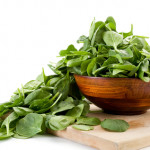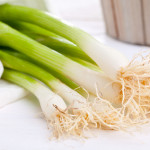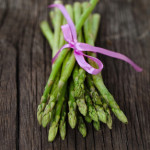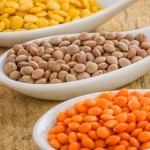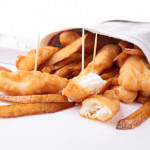A Fish Bone In Your Throat?
If you miss a bone and don’t discover it until it’s halfway down your throat, don’t panic. Bite off a piece of bread, chew and swallow it. It will take the bone with it, out of harm’s way.
“Work With What You Got!”
© Victoria Hart Glavin Tiny New York Kitchen All Rights Reserve
Fresh Spinach
Spinach is available year round, but is especially sweet and tender in the late spring, when growing conditions are perfect.
Spinach is so versatile; you can eat it for breakfast, lunch, dinner, and dessert! In Tuscany, the leaves are baked into a pie with almonds, sugar, and candied lemon peel called torta co’bischeri agli spinaci. Leave it to the Italians to create a spinach dessert.
http://www.npr.org/2013/03/28/175478107/tuscan-pie-a-sweet-springtime-take-on-spinach
When shopping for spinach the leaves should be crisp and free of moisture. Avoid spinach with broken or bruised leaves.
If you purchase bagged greens (yes, I know there is a big controversy on bagged greens) they will most likely last twice as long as the leafy bundles. Bagged spinach is handled less and exposed to less moisture. Make sure to check the “best by” date to use the leaves when they are at their peek. If they are dark or clump together, just pass them by.
Spinach grows in sandy soil, so if you by bundled spinach it most definitely won’t be prewashed. Just give the leaves a generous soak in cold water, changing it out once or twice, until there is no more grit in the bottom of the bowl.
To Prepare Spinach (1 Pound): Wash and drain. Remove stems and tear into pieces (12 cups torn).
Conventional Cooking Directions: Cook, covered, in a small amount of boiling salted water for 3 to 5 minutes or until tender. Begin timing when steam foams. OR steam for 3 to 5 minutes. Microwave cooking is not recommended.
How To Store: Rinse leaves in cold water and thoroughly dry. Place leaves in a storage container with a paper towel and refrigerate for up to 3 days.
Baby Spinach isn’t actually immature flat-leaf spinach, but a different variety entirely.
Flat-Leaf Spinach has large leaves that turn silky once slow cooked. They have an earthy flavor that tastes great in dishes like lasagna or soup.
It takes 8 cups of raw spinach to make just 1 cup of cooked. Make sure that you have enough spinach for your recipe.
Raw spinach has 33 percent more folate and 187 percent more vitamin C than cooked, since those nutrients are vulnerable to heat. On the flip side, cooking spinach deactivates oxalic acid, a compound that prevents the absorption of certain nutrients, so you get 32 percent more iron and nearly 40 percent more calcium than raw. Have a salad today and sauté tomorrow.
“Work With What You Got!”
© Victoria Hart Glavin Tiny New York Kitchen All Rights Reserved
Storing Baked Goods
Always allow baked goods to cool completely (preferably on a wire rack) before wrapping and storing. If they are wrapped before they are thoroughly cooled, pastries will steam, turning their nice crisp surfaces soggy and limp. The texture and flavor of most baked goods fare best when stored, well wrapped, in a cool dry location for a couple of days. However, those that are particularly high in moisture will be safest stored in the refrigerator.
“Work With What You Got!”
© Victoria Hart Glavin Tiny New York Kitchen
Ramps
If you can’t find any of those oh-so-fleeting ramps at your local farmers’ market then have no fear, as there are plenty of other onion options available this time of year. Turn to Tiny New York Kitchen’s favorites.
Scallions: A supermarket staple. They have a peppery bite that isn’t overpowering. Scallions (Green Onions) are best used chopped raw or charred in salads or as a garnish.
Leeks: Leeks have a slight garlic flavor that mellows when cooked. Braised to an almost creamy texture, they are one of the best side dishes.
Spring Onions: Spring onions are a more mature scallion with large, sweet bulbs and pungent, spicy green tops. They are excellent for roasting whole and finished with sea salt and s bit of lime juice.
Flowering Chives: These mature chives are bursting with gorgeous purple flowers that taste just like wonderful chives. Use both flowers and finely cut stems in salads.
“Work With What You Got!”
© Victoria Hart Glavin Tiny New York Kitchen
Cooking Ham
Ham is a great choice for spring gatherings. It’s simple, feeds a crowd and provides wonderful leftovers.
Keep Servings In Mind. Allow for 1/2 to 3/4 pound per serving for bone-in ham, and 1/4 to 1/2 pound per serving for boneless ham.
Before Cooking make sure to let ham sit at room temperature for approximately 1 hour.
Scoring The Skin adds to a beautiful presentation. Cut 1/4 inch deep crosswise into 1 to 2 inch squares to create classic diamond shapes.
Glaze The Ham during the final hour of cooking to avoid burning.
Keep The Flavor Going. Buying bone-in ham leaves you with the ham bone, which is great for flavoring soups and beans.
“Work With What You Got!”
© Victoria Hart Glavin Tiny New York Kitchen
Asparagus
Nothing quite says spring like asparagus, which has a rather short season, which is typically from February to June.
Thickness really has nothing to do with quality. Asparagus is a perennial; more mature plantings tend to yield thicker stalks, and any size will be tender as long as it’s freshly cut. Look for bright apple green spears and tightly closed purplish heads; the stalks should be glossy, firm, and unwrinkled, with just a little white toward the base.
The question that many people have about Asparagus is whether to peel or not to peel. I believe it is quite unnecessary, and for the effort, it just doesn’t make noticeably more asparagus flesh available for eating. Instead, bend the cut end of each spear, snapping off the woody part where it breaks naturally (usually about two-thirds of the way down the stalk). The balance of the spear will be tender to the bite.
Extend the freshness of asparagus by keeping the spears hydrated. When you get the asparagus home from the market, trim the bottom 1/2 inch or so from each stem, and stand the bunch upright in a large coffee cup. Add water just to cover the ends of the stems, and then cover the top of the bunch with a plastic bag. Or you could trim 1/2 inch off the base of the stalks, wrap the bottoms in a damp paper towel, and slip the spears into a plastic bag, leaving the bag open. In either case, make sure to refrigerate the asparagus, adding more water to the cup or dampening the paper towel as needed. The asparagus should stay fresh for up to 3 days.
“Work With What You Got!”
© Victoria Hart Glavin Tiny New York Kitchen
Peas
There are several types of fresh peas, all of which are available nearly year round these days, but they are at their peak during the spring and early summer months. Like corn, the natural sugar in peas converts quickly to starch, so make sure to buy peas fresh, store them in the refrigerator, and use them within a day or two.
English shell peas are the familiar round green pea. Frozen tiny tender green peas, while enjoyable and convenient throughout the winter months, bear little resemblance to the texture and bright flavor of fresh peas. The springtime ritual of shelling peas is just as satisfying as shucking summer corn, and their flavor and texture are worth every minute.
When shopping for English peas, look for bright green smooth, succulent pods filled with evenly plump, round seeds. The freshness of the pods is an indication of the freshness of the peas. For the most reliable test, pop open a pod and taste a pea. Fresh peas should taste sweet and grassy. A pound of English shell peas in their pods yields about 2 cups of shelled peas, which translates into 2 to 3 servings.
Both sugar snaps and snow peas are edible pod peas. There is no shelling required. As their name implies, sugar snaps are delightfully sweet. Sugar snaps are delicious raw, but their flavor is enhanced with a brief cooking. As with all other peas, look for bright, smooth, succulent, tender green pods with fresh looking stems.
Happy Spring!
“Work With What You Got!”
© Victoria Hart Glavin Tiny New York Kitchen
Lentils
The lentil is a Eurasian herb grown for its small, flat, edible seeds and are considered a legume. They are lens shaped (the word comes from the Latin lens, “lentil”), variously colored on the outside, and yellow/orange on the inside. The earliest written mention of lentils is in the book of Genesis: Esau sold his birthright in exchange for a dish of lentils. Lentils are high in fiber, vegetable proteins, and complex carbohydrates and fairly rich in iron and protein; they are low in sodium and fat-free.
Work With What You Got!”
© Victoria Hart Glavin Tiny New York Kitchen
In case things get too hot, a teaspoon of sugar after eating something REALLY spicy will neutralize the heat sensation!


